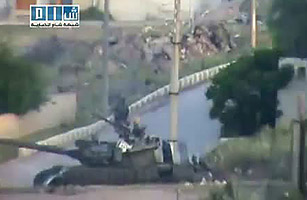
If human rights workers and journalists are ever allowed into the besieged southern Syrian city of Dara’a near the Jordanian border, what horrors will they find? Syrians always had good reason to avoid rebelling against their authoritarian regime, ignoring early calls to join the Arab Spring. The stakes — as the world can now see through the spotty news from social media and smuggled amateur video — were always going to be extremely high.
On Monday, the government crackdown against the five-week long uprising escalated sharply with the military storming into Dara’a, the birthplace of the revolution, rolling in with tanks and cutting off electricity and telephone services to the city. Tanks moved into the town after dawn prayers, coming in from four directions, rights activists and witnesses said. Some 25 people were killed, the activists say, a toll expected to rise. On Thursday, President Bashar al-Assad rescinded the country’s 48-year emergency law, but just a day later, more than 120 people were killed in protests across the country. There has been a steady uptick in violence ever since. Still, the deep military push into Dara’a is the most aggressive in a series of hostile actions by Assad’s regime against essentially unarmed protesters calling for greater civil liberties.
“It’s clear there’s now a strategy to crush any form of dissent using overwhelming force,” Nadim Houry, Human Rights Watch’s senior researcher for Syria and Lebanon, told TIME. “There’s been a decision that they will tolerate no more dissent and that this has to end… They are still operating as if they’re under the emergency law, picking up people without arrest warrants, nothing has changed. if anything it’s gotten worse.”
A resident of Dara’a contacted by the France 24 Arabic satellite channel speculated that the escalation may have been in response to a protest in Dara’a on Sunday. “The people were chanting ‘there is no going back, there is no going back’ and ‘the people demand the fall of the regime’,” said the resident, who was not named. “They are shooting at us. I saw snipers on the rooftops. They’re shooting at the houses, listen! listen!” he said, pausing for a moment while the sound of heavy gunfire was clearly heard over the phone. “Where are the Muslims? where are the people? We are Dara’a, not Israel!” he screamed. The channel’s anchor said in later broadcasts that the station was unable to contact the witness again because phone lines were cut.
Ayman al-Aswad, a resident of Dara’a who contacted al-Jazeera using a Jordanian SIM card, said bodies were strewn in the streets. “We’re not hearing any ambulances,” he said. “There’s a lot of black smoke rising across the city. Nobody is able to leave their homes, there’s heavy gunfire.” Repeated attempts by TIME to obtain first-hand accounts from Aswad, as well as more than half a dozen other residents in the city who have Syrian, Jordanian, and even Saudi telephone numbers, failed. The calls would not go through.
Rights activists told TIME that movement in and out of the city was heavily restricted from late last night, with soldiers at checkpoints searching vehicles, scouring mobile phones for video or images, and checking IDs. The stranglehold was tightened on Monday, with the closure of the nearby Jordanian border, a move the Jordanian government said was at the request of the Syrian authorities. “There is talk that there are armed elements trying to enter Dara’a from Jordan, so the decision was made to return stability to Dara’a,” Taleb Ibrahim, a Syrian pro-government political analyst told al-Jazeera. “We don’t want Salafists or other extremists to enter Syria. There are ongoing military operations in the area, so they have closed the border for now, it’s for logistical reasons.”
Ibrahim denied that the military was moving against its own people, and said nine soldiers were killed in the city on Monday. “There were offensives against army positions in the area, the people of Dara’a asked the army to step up and fulfill its responsibility, so that’s what it’s doing,” he said. Rights activists confirmed the deaths of the nine soldiers, as well as five officers, but claimed that they were killed for failing to follow orders to shoot civilians.
It’s hard to separate truth from spin, but images — although they cannot be independently verified — may paint a picture of events. In one video purportedly filmed in Dara’a, a group of unarmed young men defiantly stand their ground as a tank approaches. One man, dressed in a striped sweater and baseball cap, throws a rock which meets its metal target with a clink. “You traitors!” a voice off-camera screams, apparently at the soldiers. “You traitors!” In another video, soldiers get into position near a tank, as others crouch behind a low, naked cinderblock wall and take aim as intense gunfire crackles. And in yet another also reportedly from Dara’a, streams of heavily armed soldiers in flak jackets cross a grassy field, behind several tanks. The soldiers then sink into the position, lying low in the field as they aim their weapons while dozens of unarmed civilians watch nearby.